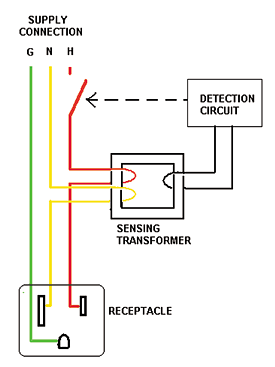
The Hazard
A 120-V receptacle circuit contains three wires: a phase conductor, a neutral, and a ground. The motor winding, heater element, or other load device is connected between the phase wire (also called the "hot" wire) and the neutral. In normal operation, current flows from the source through the phase wire, through the load, and back to the source through the neutral wire. The ground wire is bonded to the neutral at the service and the equipment enclosure at the load and normally carries no current. Its only function is safety; it provides a low-resistance path to carry any current that "leaks" from the energized conductors due to failed, dirty, or wet insulation back to the source.A good ground path ensures that the enclosure remains at zero voltage with respect to other grounded objects. Should this path be broken or develop a high resistance at any point between the receptacle and the service, leakage current may energize the enclosure to a voltage approaching the 120-V line. If a person contacts the energized enclosure while touching or standing on a grounded surface, leakage current can flow back to the source through the body.
Ground leakage currents represent a danger to personnel because only a very low current is required to affect the human heart rhythm. The typically cited threshold for inducing ventricular fibrillation in an average adult male is only 100 mA (100 thousandths of an Ampere). A 120-V supply circuit can push this much current through a total resistance of 1,000 Ohms, which is in the range of the resistance of a human body with skin-to-conductor contact. Leakage currents this small are orders of magnitude below normal load current and thus not detected by fuses and circuit breakers.
The Solution
Detecting and interrupting ground leakage currents is the role of the GFCI, whose operating principle is shown in Figure 1. Current flowing in a wire creates a magnetic field around the wire, which can induce a voltage in another wire placed in the field without a physical connection between the two wires. In the GFCI device, a sensing transformer is arranged so that the magnetic fields created by the hot and neutral wires are summed. If all of the current flowing through the hot returns through the neutral, the fields cancel each other, and no voltage is induced in the sensing transformer. Ground leakage current flows in the hot but does not return through the neutral, producing a net magnetic field which induces a voltage proportional to the "missing" current in the sensing transformer. When this voltage exceeds a preset value, the detection circuit switches open the circuit.These devices are available both as receptacles and as circuit breakers. A GFCI receptacle can be a standalone installation or can be wired to protect standard receptacles connected to it. A GFCI circuit breaker protects all receptacles connected to it. All GFCI devices for personnel protection are required to trip at 5 mA of leakage current.
Application
The NEC requires GFCI protection only in specific locations. In residences, this includes bathrooms, kitchens, garages, unfinished basements, crawl spaces, and outdoors. In commercial facilities this includes all bathroom and rooftop locations, construction sites, marinas, and boatyards, wet locations in health care facilities, at pools, fountains, and impedance heating applications.Although not required by the code, it is common practice and advisable to provide GFCI protection for all wet locations and outdoor receptacles as well.
Some types of equipment, including appliances with large motors, have inherent leakage current levels that exceed the 5 mA trip setting of a GFCI and may cause nuisance tripping of GFCI devices. For this reason, the NEC exempts from the requirements for GFCI protection a receptacle dedicated to a single appliance, which is not accessible for other uses. This equipment must rely on a solid grounding connection to maintain the enclosure at a safe potential under these low levels of leakage current.

